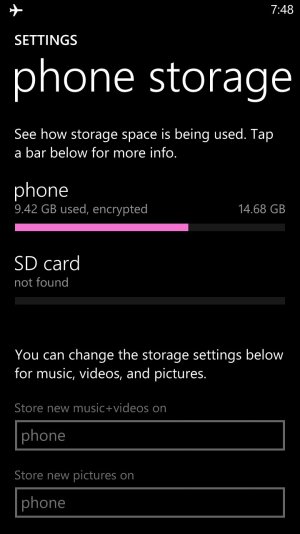- Dec 16, 2011
- 114
- 0
- 0

As the title says, I have successfully encrypted my Windows Phone device memory by activating BitLocker, and since the information regarding all of this is so vague online, I want to share my experience and offer some definitive information. I'm writing this for those who place maximum priority on utilizing every avenue available for data security since they understand the relevance of a subject like data encryption.
I have spent an ungodly amount of time researching this subject because I'm pondering leaving BlackBerry for Windows Phone, and it is imperative to me I be allowed to encrypt my device memory. I've been calling a handful of 800/877 Microsoft numbers, spent time in many MS support live chats and both MS and non-MS forums and info sites simply trying to find out how to encrypt my device memory and nobody had anything concrete, just run arounds.
If you look at a site like this:
Windows Phone for business | Security | Windows Phone (United States)
You would think this is what you're getting when you buy a Windows Phone and what you read on that page isn't entirely true. Some of the security of Windows Phone isn't available to consumers, at least not exactly, hence why the information above is under the "Windows Phone For Business" section of Microsoft's site, because there are security functionalities on Windows Phone that can only be pushed via a very specific EAS IT policy.
The screenshot above from the Settings>Phone Storage menu is what you see when BitLocker has been enabled. To clear the speculation I've seen all over the place:
*Windows Phone is NOT encrypted by default, it is not encrypted at first boot or out of the box. It leans on protocols like MTP rather than standard mass storage access so to a small point, you can't directly access your data, but while walled off from the average user, it isnt't encrypted. Apps on the device however are code signed and sandboxed.
*Adding any sort of Exchange account to the device (including Outlook.com email) does not enable or give the option to enable encryption.
So, how did I manage to do this? Well, I can say it is possible if you do not have your Windows Phone in an enterprise environment to push IT policies to your device(s) and that is by either setting up your own Exchange server, or utilizing a paid option for one already in place.
Microsoft is offering a one month free trial for a lot of their Office365 and Exchange host services. I signed up for the only one that allows advanced IT administration, and that is the Office365 for Enterprise E3 package, which goes about $20 per month, and among the various Office365 and Exchange packages available, this is the only one that allows you to enable various on-device security capabilities with policies. You don't have to spend a dime after the trial ends and in the future, you can look at it as a one-time fee if the need arises to encrypt a different Windows Phone.
Here's how you do this; once all of your services are set up you configure your Exchange email address and associate whatever IT policies you need to it, and this includes a tick box for "require device encryption." After that is done, you go into the accounts menu in Windows Phone and add this address to your accounts. After it connects, the device will ask if you want to accept the policies and once you do, BitLocker becomes enabled. Once you've done this, your Windows Phone is encrypted for the life of the install, or in other words it will stay encrypted unless you do a factory reset of the device. At this point, you are done with Exchange, you are welcome to go into your accounts menu again and completely remove the new email address from your phone. So just to be clear, no matter what you do from here, your device memory will remain encrypted unless you do a factory reset on the device or use an Exchange account to manually push a new policy to the device disabling Bitlocker.
That's it folks. It's relatively easy once you figure your way around the Web interface and again, if data security matters and you are dead set on Windows Phone, this is the only way this can be done. It's a shame other platforms allow you to do such a simple function by pulling up it's respective settings menu and simply tapping enable. My experience with this had lead me to believe Microsoft does not feel the regular consumer has a need for such data security measures, and for people who place their highest priorities on what apps they can get or how many cores are in their CPU, that's probably true. They may change that in the future with security becoming an ever growing issue, but who knows.
As far as I know, the process I've detailed is the only way for a regular consumer to encrypt their device. To whomever it concerns, good luck. As for me, I believe I'm about ready to make that all-in jump to Windows Phone and depart a fair history with BlackBerry, I just wish my carrier (Sprint) had a Nokia Lumia. If I had the kind of money to do so, i'd switch carriers, but in the meantime, here goes.

